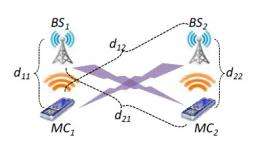December 15, 2010 weblog
Beamsteering for mobile devices could cut power consumption in half

(PhysOrg.com) -- When turned on, today’s smartphones and other wireless devices radiate power in all directions while searching for communications nodes. But this omni-directionality can pose problems, such as limiting network capacity by causing interference among devices, as well as unnecessarily consuming power. However, if mobile devices could transmit power in a specific direction rather than all directions, researchers estimate that it could cut each device’s power consumption by half. Now, a team from Rice University has developed a beamsteering technique for smartphones, Netbooks, and e-book readers that transmits power in one direction only.
Although beamsteering has been previously used for base stations and other large applications, its bulky size and power requirements have so far prevented its use for mobile devices. But Rice engineers Hang Yu, Lin Zhong, and Ashutosh Sabharwal have shown in a paper posted on arXiv that beamsteering technology can be made smaller and with minimal power requirements.
They show that employing beamsteering with four antennas can be easily integrated into a Kindle or iPad, and the power requirements are more than compensated by the device’s reduced transmit power. Simulations showed that the four-antenna technique reduces a mobile device’s overall power consumption by up to 55%, while a two-antenna technique could achieve a 40% reduction in power consumption.
As the researchers explained, taking advantage of beamsteering involves dealing with trade-offs. Many antennas require more overhead power and may cause interference with other devices, but also provide a more directed beam with lower device power consumption and thus high device efficiency. To help find the best compromise, the researchers developed software called BeamAdapt to be used on all mobile devices. BeamAdapt negotiates among mobile devices to determine the broadcast settings that provide the best transmission for everyone.
Although making this technology standard on all mobile devices might be prohibitive, it has great potential for significantly reducing the power consumption of increasingly popular mobile devices. Even if the concept could become widespread, the engineers note that more research needs to be done before commercialization.
“Making mobile clients directional is a radical departure from existing and emerging wireless technologies,” they write in their study. “While we demonstrate the potential benefits from beamsteering clients in network capacity and client efficiency, much more research is needed in all layers of the network system in order to fully realize such potential.”
More information:
Hang Yu, et al. "Beamsteering on Mobile Devices: Network Capacity and Client Efficiency." arXiv:1012.2830v1 [cs.NI]
via: The Physics arXiv Blog
© 2010 PhysOrg.com
















